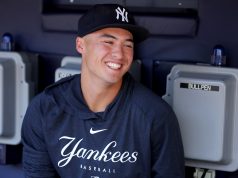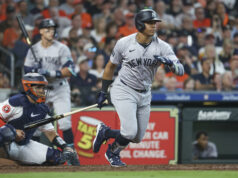During early struggles for New York Yankees’ young outfielder Aaron Judge, he has made key adjustments to tap into his full potential at the big league level.
Following a memorable start to Aaron Judge’s career in which he drilled two home runs in his first two career games for the New York Yankees, things traveled downhill in a hurry.
From the day after he hit the two dingers to start his career up until Tuesday night, the 23-year old owned a .154 batting average, no home runs, and an incredibly porous 54% strikeout percentage.
The cause? A situation that riddled him from the day he stepped foot onto PNC Field in Triple-A last season. Pitch recognition.
For those who fail to remember, after the monstrous 6’7″ outfielder batted .284 and smacked 16 home runs in 63 games for Double-A Charleston a year ago, he struggled vigorously when he was sent to Scranton/Wilkes-Barre.
His strikeout percentage rose from 25% to 29% upon his promotion as he saw his OPS plummet from .350 to .308 while he was failing to adjust to enhanced offspeed pitches, at the time.
It evened out this season, however, as Judge went on to lower that percentage to 23% for the Railriders while leading the International League with 19 homers until he was promoted to the Bronx.
The main adjustment the big guy made when struggling in Triple-A was cashing in on his pitch earlier in the at-bats because, like he told Mark Feinsand of the Daily News, hitters usually see one to two pitches they can truly drive on a nightly basis compared to half a dozen he might see in the minors or lower levels.
SEE ALSO: Returns From Ivan Nova Deal Announced
That’s what it’s all about. Even when Judge struggled in the Electric City, he was hitting the ball hard to all parts of the field which is a recurring theme here as his average launch speed is 101.74 MPH compared to the league average of 89.25 MPH, according to StatCast. So that’s not the problem.
During his struggles dealing with the curve since his promotion (0-for-8 with four strikeouts against curveballs entering Tuesday), he wasn’t quick to jump on fastballs early in counts, which is a pitch he has the ability to crank 500-plus feet.
While Edison Volquez tried to jam him inside with fastballs during the second inning of Tuesday’s 5-4 win for the Yankees, Judge did a tremendous job of laying off the ones that rode in on him in order to get in a hitter-friendly 2-1 count.
Then, while thinking inner-half, Judge got a nice juicy fastball over the middle of the plate and did not miss it as he annihilated it 408-feet to left-center field.
There is nothing mechanically wrong with Aaron Judge. Sure, his overall strikeout percentage is over 40% in just 15 games in the show but the biggest difference from the minors to the majors is that, along with the superior breaking ball, you don’t have a surplus of opportunities to earn a gift down the pipe.
When you get that gift, however, the key is to not miss it. Last night’s at-bat in the second inning shows you that Judge has the ability to be aggressive at the dish and cash in on a rare pitcher’s mistake.
Last night’s long ball should also remind you to stay patient with one of the most promising young stars in the organization.
Many said he faces adversity in regards to his height, which is a legitimate obstacle. But many expected him to come onto the big stage and crank home runs outside of Yankee Stadium at a Gary Sanchez-like pace.
That certainly is the ideal expectation for Yankees’ fans, but just remember that these kids would not be here if it weren’t for a fire sale at the deadline.
The original plan was to have guys like Judge, Sanchez, Tyler Austin and more dominate at the Triple-A level until 2017.
The last core that started the late-1990’s dynasty took a year to get well acquainted with the big leagues in 1995 and then starred in ’96. Consider this year ’95. Although that doesn’t make much sense, these kids are just getting their feet wet and that includes Judge.
Since we’re on the topic of history, though, Judge’s history should tell you that he knows how to identify a problem (which he has) and his best trait is that he adjusts, in time, to every level he has been on.
After last night’s aggressiveness on Volquez’s fastball, the verdict is in. Judge will adapt.












